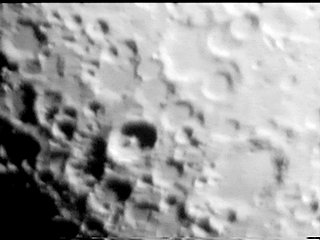
9 day-old moon

9 day-old moon
Scanning Data:
61%, waning
Range: 232,440 miles
960822 2000 MT 01h00m CUT
Tracking Camera: Panasonic WV450
Scanning Camera: GBC CCD-400
Scope: 16“ f/4.5, 1830mm fl
T-C Adaptor: Orion variable universal camera adaptor, set at min
Ocular: Sirius Plossyl 26mm/Orion #11 yellow/green Wratten filter

Scope configuration as shown, Meade 16" f/4.5 mounted
on DOB turret.

Report:
As usual, the scanning camera image was overwhelming at 400 power,
putting us about 600 miles from the lunar surface. When sky conditions
improved we pumped-up the magnification to 550. The Session began at 8:00
PM. The sky was clear with a little haze making the Moon a little orangy,
but better than nights previous. The images were very good, and the ability
to control the big monster 16" f/4.5 scope from down in the facility was
realized as we became more and more accustomed to the pendant control,
and in the comfort of air conditioning.

This is an HPS view at 400x
We did a routine scan of the lunar surface in the PAN Mode and let the Earth's rotation do the scan sequence, then pulled the limb back to the start position. When we passed over the lunar highlands, the sight was spectacular. This area is dominated by the crater Tycho, one of the most prominent craters on the Moon and the center of the most extensive system of bright rays. .
After the initial PAN to directly over Tycho, we hit the correct buttons on the hand control in the basement control room, putting us into the "TRACK" mode. Everything suddenly slowed down on the monitor. The Earth's rotation was no longer evident. In a few seconds we had Tycho dead center. Within less than a minute with a few corrections by re-placing Tycho in the center of the monitor, we were in full tracking mode.
The Moon's youngest large crater is 52-miles wide, with the top of its massive central peak glowing a fuzzy white and the crater bowl about half bathed in shadow. Tycho's extensive network of terraces could be seen to dominate the inner walls. A fuzzy, cloudlike area at the 5 o'clock position turned out to be terracing or slumped debris. This corresponded very well to our Lunar Orbiter shot we had posted on the wall.
We spent most of our time on Tycho, with concentrated scans also on the areas well-illuminated and delineated by near-terminator shadow. These areas included the Apennine Mountains, Rupes Recta (the Straight Wall"), Eratosthenes, etc. Sinus Medii was was easy to spot, but too far into the washed-out areas to show any detail.
By exiting out of "TRACK" and going back to "PAN" we moved to various areas of interest. By going back to "TRACK" we were automatically still locked in.
There were no obvious anomalies observed during the live scans, nor any "fastwalkers". What looked like a "fastwalker" in a few frames was so close and so fast that it was no doubt some type of bird. The next day we rechecked the image by going into slow motion, then actually "froze" the image at times. The wings were clearly visible. When we pumped up the power to 550 several times during the session, the images weren't clear enough and we were afraid we might miss something and went back to 400.
While reviewing the Tycho images it was discovered that the central peak was very fuzzy and had what appeared as "streamers" going in several directions. This is some of the stuff that we were expecting during the Tycho event of August 7th, although no brightening was observed in the shadow area.
Francis Ridge
Coordinator,
The Lunascan Project